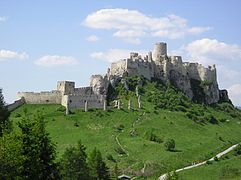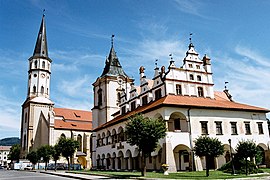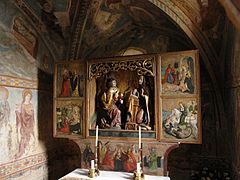
The Eastern Slovakia is the easternmost part of the Slovakia. After the East Slovak Regional Association (Východoslovenský kraj) Was dissolved in 1990, the eastern Slovak region, which is almost identical to this Kraj (Východné Slovensko) today as a NUTS 2 region, it is only of statistical significance.
Regions

Tourist regions
- Tatra Mountains (Tatry)
- High Tatras (Vysoké Tatry)
- Low Tatras (Nízke Tatry)
- Zamaguria
- Šariš
- Zips (Spiš)
- Levočské vrchy (German Leutschauer Berge)
- Gemer
- Abov (Kaschauer Land, Košice a Okolie)
- Lower Zemplín / East Slovak Plain (Dolný Zemplín)
- Upper Zemplín (Horný Zemplín)
- Vihorlat Mountains
Administrative regions
_-_Main_Street_4.jpg/220px-Kosice_(Slovakia)_-_Main_Street_4.jpg)
The Eastern Slovakia region consists of the two regional associations
- Prešovský kraj (Preschauer Landschaftsverband) and
- Košický kraj (Košice Regional Association)
places

- Košice - “Capital” of Eastern Slovakia and former European Capital of Culture
- Prešov - the third largest city in the country and the center of the Šariš region
- Bardejov - Old town with spectacular main square (UNESCO World Heritage)
- Jasov
- Kežmarok - historical town with a lovely wooden Protestant church (UNESCO World Heritage)
- Levoča - well-preserved old town (UNESCO World Heritage); with a popular rural depiction of the Last Supper in the city cathedral
- Michalovce
- Poprad - Winter sports resort and “base camp” at the foot of the High Tatras; pretty old town
- Spišské Podhradie - Spiš Castle and Spiš Chapter (UNESCO World Heritage), St. Martin's Cathedral, Žehra Romanesque church
Other goals
- High Tatras - the only high mountains of the Carpathians
- Slovak paradise - Mountain range and national park, characterized by numerous gorges and smaller waterfalls and caves
- Poloniny National Park with the primeval beech forests of the Bukovec Mountains
- Medzilaborce - Hometown of Andy Warhol's ancestors
background
With the exception of the extreme southwest of the region, where the region merges into the Hungarian lowlands, eastern Slovakia is through the Carpathian Mountains embossed.
Economically, Eastern Slovakia was considered the most backward area of Czechoslovakia, and this continued even after independence. In addition to agriculture, forestry and mountain tourism, mining is the most important industry in the region. There is only a few big cities with an industry worth mentioning.
language
The majority of the population speaks Slovak, some Eastern Slovak dialects differ greatly from the standard language. There are also locally significant minorities of Ruthenians, Ukrainians, Poles and Hungarians. Numerous Sinti and Roma live in the Zips in particular.
In tourism establishments you can get on well with the foreign languages English and German, but the rural population is not as familiar with these foreign languages as in the west of the country. Russian is still widely understood by the older population. With basic knowledge of a Slavic language, rudimentary communication is usually possible.
getting there
By plane
International airports are located in Košice (KSC) and Poprad Tatry (DID). While there are several international scheduled connections in Košice (including daily from Vienna and Prague), Poprad mainly offers seasonal charter connections, none of them with German-speaking countries.
In the wider area you can also use the Krakow Airport (160 km from Poprad, 2½ hours by car or bus), Debrecen (200 km from Košice, 2:20 hours by car) or Budapest (265 km from Košice, 2:50 hours by car or shuttle).
By train
Several express trains daily commute between Bratislava and Košice with stops among others. in Poprad and Spišská Nová Ves. The journey from Bratislava takes 4–5 hours to Poprad and 5–6 hours to Košice.
The SuperCity runs once a day from Prague and the RegioJet three times to Poprad (6–7 hours) and Košice (7–8 hours). The LEO Express runs once a day from Prague to Poprad, Spišská Nová Ves and Prešov (8 hours).
There are also direct trains from Vienna (main station, via Bratislava and Poprad) and Budapest (Keleti, via Miskolc) to Košice. Eastern Slovakia can also be reached by train from the Ukraine; there is a gauge change facility in Chop. So you can take the night train to Eastern Slovakia every day. from Kiev, Lviv and Mukacheve.
In the street
There are two high-level road connections by car from Bratislava, but their expansion to the motorway in the eastern part of the country is still patchy: You can drive either via Žilina or via Zvolen. From Vienna it can often be faster to take the Hungarian motorways via Budapest and Miskolc instead.
While there are numerous low-level roads that cross the borders with Hungary and Poland, there are only two border crossings with Ukraine: one near Uzhhorod and one near Velikyj Bereznyj. Longer and more stringent passport and customs controls at the EU's external border, especially when entering the EU, are to be expected. Even if there is not much going on, crossing the border can take three hours.
mobility
In addition to regional trains, regional buses also run to the remote areas. It is worth mentioning the local railway in the area of the High Tatras, which runs from Poprad to the various health resorts and also connects them with each other. The road network is well developed and there is little traffic apart from the main connections. Numerous cycling and hiking trails are signposted.
Tourist Attractions
- Spišský hrad (Spišský hrad), one of the largest high medieval castle complexes in Central Europe, as well as Spišská kapitula and the Romanesque Holy Spirit Church in Žehra near Spišské Podhradie (world cultural heritage)
- Old town of Levoča with works by the late medieval sculptor Paul von Leutschau (World Heritage Site)
- other historical places and fortified churches of the Spiš
- historical center of Bardejov (world heritage site)

Spiš Castle

Spiš chapter

Žehra Church

Levoča Town Hall and Cathedral
Bardejov main square
- Wooden churches in the Carpathian Mountains (World Heritage): Bodružal, Hervartov, Kežmarok, Ladomirová and Ruská Bystrá
- Old town of Košice
- Churches in the regions of Gemer and Abov with medieval wall paintings
.jpg/271px-Bodružal_(11).jpg)
Wooden church in Bodružal

Wooden church in Ruská Bystrá

Cathedral and St. Michael's Church in Košice
Altar in the Church of the Annunciation in Chyžné
- Slovak Karst Caves (World Natural Heritage): Dobšiná, Slavec-Gombasek, Jasov, Ochtiná and Kečovo-Domica
- Primeval beech forests in the Carpathian Mountains (World Natural Heritage): Stužica, Rožok, Havešová - the tallest beeches in the world grow up to 54 meters here
- the mountains of the High and Low Tatras
- Geyser in Herľany

Dobšiná ice cave

Domica cave

Stužica primeval beech forest
Kriváň in the High Tatras

Herľany geyser
activities
- Mountain hiking, not only in the High Tatras, has now also been possible across borders since Slovakia and Poland joined the Schengen area.
- In winter there are some smaller ski areas. Cross-country skiing is also very popular in eastern Slovakia.
- Zemplínska šírava and Veľká Domaša swimming lakes
kitchen

Eastern Slovakia is known for hearty, hearty cuisine based on brimsen and bacon. Bryndzové halušky (Brimsennockerl - the Slovak national dish) or Bryndzové pirohy (Brimsen pierogies) originally come from there and have spread throughout Slovakia. Both contain brimsen (bryndza), a salted cream cheese made from sheep's milk. The smoked Ostriepok cheese is also a local specialty, be it as a loaf or as a plaited cheese.
Mushroom pickers will also find something in the woods.
Catering establishments can be found in every larger town.
nightlife
Notable nightlife can be found especially in the large cities of Košice and Prešov.
security
While the normal traveler has little to fear with regard to crime, the dangers of the high mountains should be pointed out in particular. Even on short mountain hikes in good weather, you should always expect surprising weather changes and don't forget to wear suitable shoes and clothing as well as a good map!
Racism: Assaults on Sinti and Roma by some groups of Slovak nationalist attitudes are the order of the day. This not only affects Sinti and Roma, but unfortunately also tourists with darker skin color. Light-skinned tourists, on the other hand, have nothing to fear. There are also some restaurants in Eastern Slovakia that have "Slovaks Only" signs on the door. As a conscious traveler, you naturally want to avoid such places in order not to support racism and exclusion.
climate
Temperate, continental climate, mountain climate in the mountains







.jpg/271px-Bodružal_(11).jpg)







